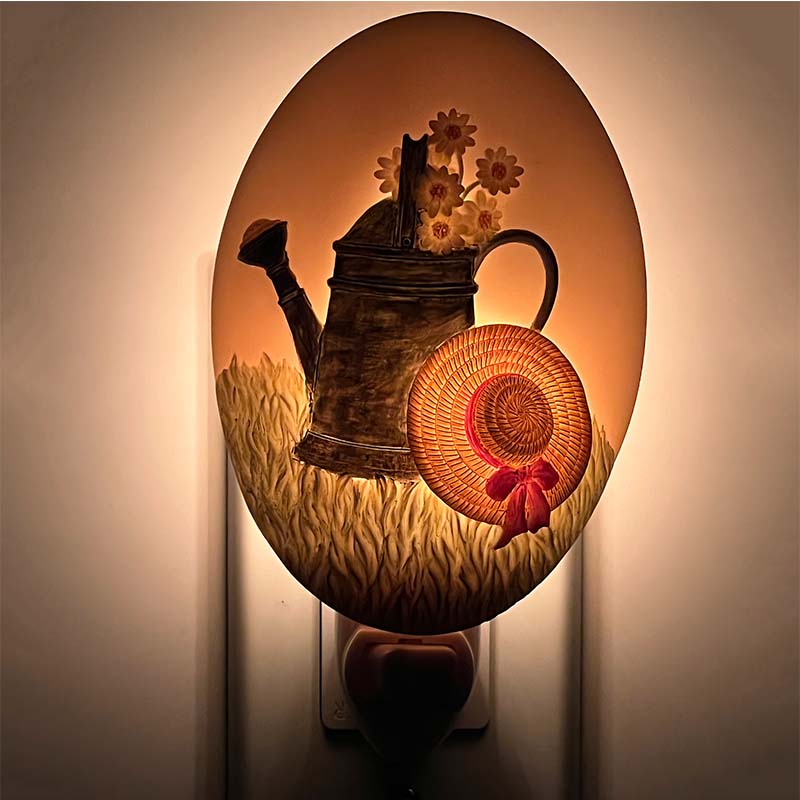Garden Watering Pot Night Light: A Comprehensive Guide
What is a Garden Watering Pot Night Light?
The Garden Watering Pot Night Light is an innovative outdoor lighting solution that combines functional illumination with decorative aesthetics. Designed to resemble a traditional watering can, this product features a water-resistant (IP65 rating) construction with energy-efficient LED bulbs (typically 3-5 watts) that provide warm white (2700K-3000K) or multicolor (RGB) lighting options. The unit typically measures 8-12 inches in height and is constructed from durable materials such as weather-resistant polyresin or powder-coated metal.
Key technical specifications include:
Luminosity: 200-500 lumens (adjustable in some models)
Power Source: Solar-powered (with 2000mAh lithium battery) or low-voltage (12V) wired options
Charging Time: 6-8 hours of sunlight for full charge (solar models)
Runtime: 8-12 hours on full charge
Material Thickness: 2-3mm wall thickness for durability

Key Features and Technical Data
1. Dual-Function Design
The watering pot design serves both decorative and practical purposes. The spout area often features a downward-facing light (30-45 degree beam angle) that creates a gentle pool of light, while the body illuminates upward with 120-degree wide-angle diffusion. Some advanced models incorporate water flow simulation effects using LED strips that mimic flowing water with dynamic color transitions at 0.5-2Hz frequency.
2. Smart Lighting Technology
Premium versions include photocell sensors (2-10 lux activation threshold) for automatic dusk-to-dawn operation and motion sensors (5-8m detection range) with 30-120 second timeout. Wireless models may feature Bluetooth 5.0 or WiFi connectivity for remote control via smartphone apps, allowing for 16 million color combinations and programmable lighting schedules.
3. Weather Resistance
Constructed to withstand outdoor conditions, these lights typically feature UV-resistant coatings that prevent color fading for 5+ years, and can operate in -20°C to 50°C temperature ranges. The electrical components are protected by silicone gaskets (1.5mm thickness) and conformal coating on PCBs to prevent moisture damage.
Application Scenarios
1. Residential Garden Lighting
Perfect for creating ambient lighting along garden pathways (spaced 1.5-2m apart), highlighting flower beds (30-50cm mounting height), or as focal points in rock gardens. The gentle illumination provides 0.5-3 lux of functional light without causing light pollution.
2. Commercial Landscaping
Used in hotel courtyards, restaurant patio areas, and shopping center gardens where they can be arranged in clusters of 3-7 units to create thematic lighting displays. Commercial-grade models often feature higher lumen outputs (500-800 lumens) and daisy-chain connectivity for synchronized control.
3. Special Events
Ideal for wedding receptions (particularly garden weddings), where they can be programmed to color-match event themes or set to slow fade transitions (0.1-0.3Hz). Their portable nature (most units weigh 1.5-3kg) makes them easy to arrange in creative configurations.
4. Therapeutic Environments
Used in healing gardens and senior care facilities, where the calming light effects (particularly the blue spectrum options at 460-490nm wavelength) can help reduce anxiety. The familiar watering can shape provides nostalgic value for dementia patients.
Maintenance and Care
1. Cleaning Procedures
Clean the exterior surfaces every 2-3 months using a soft cloth dampened with mild soap solution (pH 6-8). For solar models, wipe the photovoltaic panel (typically 5.5V/1W) with isopropyl alcohol (70% concentration) every month to maintain charging efficiency. Avoid high-pressure washers (keep under 30psi) which could damage seals.
2. Seasonal Maintenance
In regions with harsh winters (below -10°C), it's recommended to store the units indoors or cover them with breathable protective covers (200-300gsm fabric weight). For year-round use, check battery terminals every 6 months for corrosion and apply dielectric grease (0.5mm layer) if needed.
3. Electrical Maintenance
For wired models, inspect the low-voltage cables (usually 16/2 or 18/2 gauge) annually for rodent damage or insulation wear. Solar models may require battery replacement (every 2-3 years for lithium batteries) when runtime drops below 50% of original capacity.
4. Optical Maintenance
LED lenses can accumulate dirt that reduces light output by 15-30% annually if not cleaned. Use a microfiber cloth and lens cleaning solution every 4-6 months to maintain optimal brightness. For models with acrylic diffusers, apply UV protectant polish annually to prevent yellowing.
5. Software Updates
Smart lighting models should receive firmware updates every 6-12 months to maintain compatibility with mobile devices and security protocols. This typically involves connecting to the manufacturer's app and following OTA (over-the-air) update procedures that take 2-5 minutes to complete.







